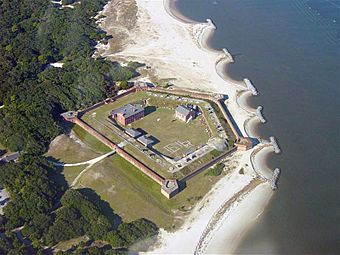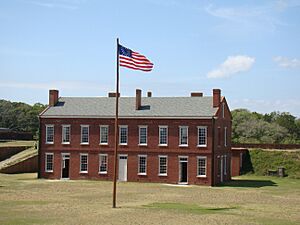Fort Clinch facts for kids
Quick facts for kids |
|
|
Fort Clinch
|
|

Fort Clinch aerial view, October 2003
|
|
| Location | Amelia Island, Nassau County, Florida |
|---|---|
| Built | 1847-1869 |
| Architectural style | Brick Masonry |
| Visitation | 167,000 (an average year) |
| NRHP reference No. | 72000343 |
| Added to NRHP | November 15, 1972 |
Fort Clinch is a historic fort built in the 1800s. It was made of strong brick and was designed to protect the coast. The United States built it as part of a big plan to defend its shores.
You can find Fort Clinch on a small piece of land called a peninsula. This land is at the very northern tip of Amelia Island in Nassau County, Florida. The fort is located near Fernandina Beach, right where the St. Marys River meets the ocean at Cumberland Sound. Today, Fort Clinch is a popular spot inside Fort Clinch State Park.
Contents
A Look at Fort Clinch's Past
Early Defenses and Construction
This important spot was first used for defense way back in 1736. The Spanish, who controlled Florida at the time, built early defenses here. Over the years, different countries that controlled Florida used this site. They all wanted to protect the entrance to the St. Marys River and Cumberland Sound.
After a conflict called the Second Seminole War ended, the United States began building a new fort in 1847. This fort was later named Fort Clinch. It was part of a large defense plan called the "Third System." This plan guided how forts were built all over the country during that time.
The fort has a unique five-sided shape, like a pentagon. It has both inner and outer walls. Workers used almost five million bricks to build it! The outer walls have special corners called bastions and openings called embrasures for cannons. Inside, there are several buildings, including a two-story barracks where soldiers lived.
Who Was Fort Clinch Named After?
The fort was named in honor of General Duncan Lamont Clinch. He was an important military leader who fought in the War of 1812. General Clinch also played a big role in the First and Second Seminole Wars. The fort was named after him when he passed away in 1849.
Fort Clinch During the Civil War
In early 1861, soldiers from the Confederate side took control of Fort Clinch. They used it as a safe place for ships that were trying to get past blockades during the first year of the Civil War.
However, new weapons were being developed. Cannons that could fire special "rifled" shells became common. These new cannons were so powerful that they could damage the fort's brick walls. This meant the fort was no longer as strong as it needed to be.
In March 1862, General Robert E. Lee ordered the Confederate troops to leave the fort. He needed his soldiers for other battles. Soon after, soldiers from the Union (Federal troops) took over the fort. They used it as their main base in the area for the rest of the Civil War.
Later Years and Restoration
After the Civil War, in 1869, the fort was mostly left empty. It stayed that way until 1898, when soldiers returned for a short time during the Spanish–American War. But in September of that year, the Army left the fort again, and it slowly started to fall apart.
During the Great Depression in the 1930s, a group called the Civilian Conservation Corps (CCC) began to restore the fort. They worked hard to make it look like it did during the Civil War. In 1935, the State of Florida bought the land around the fort.
Fort Clinch State Park, including the fort, opened to the public in 1938. The fort was closed again during World War II and used as a communication and security post. After the war, it reopened for visitors.
In 1972, Fort Clinch was added to the National Register of Historic Places. Today, visitors can learn about its role in the American Civil War. Park staff even dress up in old uniforms and show what military life was like at the fort. It's open to the public every day from morning until sunset.
Images for kids






